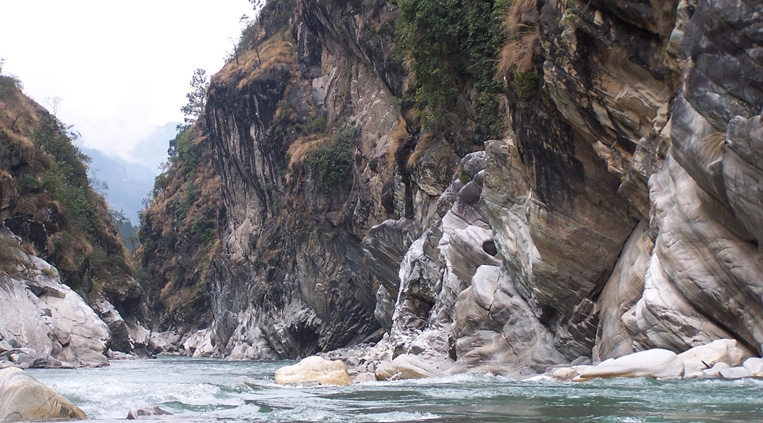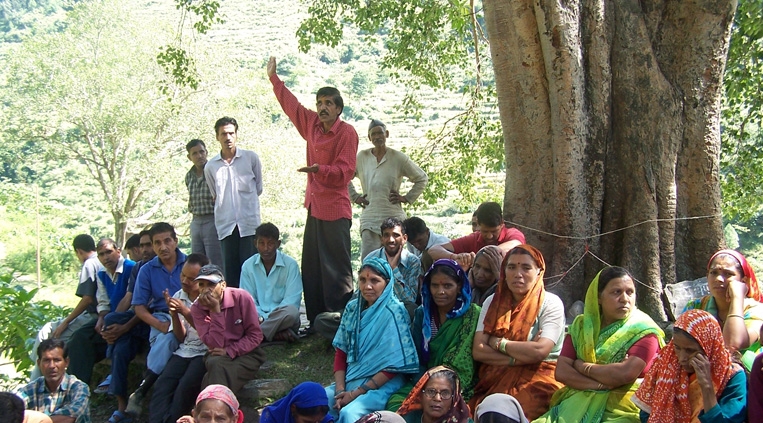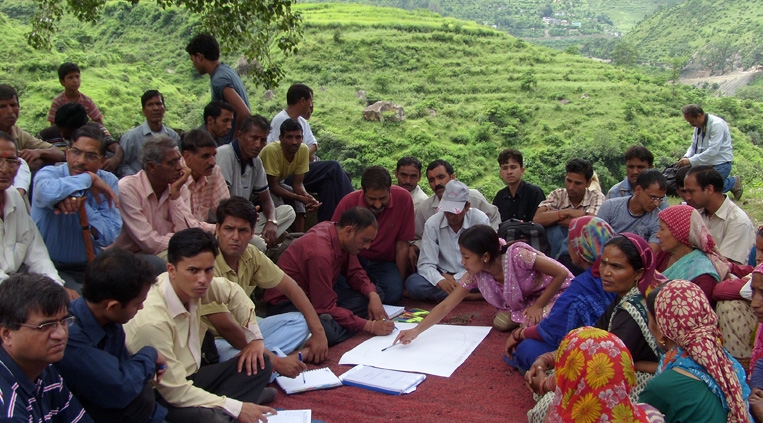 |
| The VPHEP dam will be constructed in a deep, uninhabited gorge |
The government of India has requested the World Bank's assistance to finance the proposed Vishnugad Pipalkoti Hydro Electric Project to be developed by the THDC India Ltd (THDC) on the Alaknanda River in Uttarakhand. THDC is a joint venture between the government of India and the government of Uttar Pradesh.
The Vishnugad Pipalkoti Hydro Electric Project has been designed as a 444-megawatt, run-of-river hydropower scheme which, when completed, will generate an estimated 1,665 gigawatt-hours, (or million kilowatt-hours) of electricity in a typical year. This will represent a valuable addition of peaking power to India's Northern Grid, which faces severe power shortages at high-consumption times.
Small submergence: The project will build a 65-meter diversion dam near Helang village in Chamoli district of Uttarakhand to create a small reservoir in the Alaknanda River. No village, house or field will be submerged by this reservoir as the Alkananda flows through a deep, uninhabited gorge at this point. This reservoir will store about 3.63 million cubic meters of water, the equivalent of about 4.9 hours of average flow of the river.
Environmental flows: A 13.4-kilometer headrace tunnel will carry the water to an underground powerhouse near Haat village to generate the power. A 3-km tail race tunnel will return all the diverted water back to the Alaknanda, approximately 18 km downstream from where the water was diverted. The impact of the project on downstream water quality is expected to be negligible. A minimum flow of 15.65 cumecs of water will be left in the river at all times to sustain the aquatic health of the river. This is equivalent to approximately 45 percent of the average lean season flow of the river.
THDC has conducted extensive technical, environmental and social studies and impact analyses to finalize the project design; to assess the impact of the project on the local population and the local environment; and to incorporate measures to mitigate the identified impacts.
Minimal land acquired from villagers: Given the topography of the project area -- the Alaknanda flows through a deep gorge and villages are located much higher than the waterline -- VPHEP has limited land acquisition impacts on local communities. Less than one-fifth of the 141.5 hectares required for the project is being acquired from private landowners; most of the land to be acquired for the project is government or forest land.
Some 265 families will be relocated by THDC as a consequence of land acquisition, but 242 or 92 percent of these are families from Haat village that voluntarily chose to move; they had offered their lands and houses to THDC for acquisition in order to escape the possible noise and dust disturbance that might follow construction activities in their village, which is the site of the proposed powerhouse. Although THDC did not require their land for project infrastructure, the company agreed to the villagers' requests in recognition of the possible disproportionate impacts on their village.
After due consultations with the project-affected families, THDC has adopted a Resettlement and Rehabilitation Policy for the project that meets and exceeds the requirements of India's National Policy on Resettlement and Rehabilitation (2007). In addition to compensation for land and houses acquired, THDC will also pay the project-affected families various grants and allowances (based on degree of impact) to allow them to improve their standard of living and restore their livelihoods.
Compensation for losing access to forests: Community forests are used by almost all villagers for fodder and fuelwood. The project-affected villages will lose access to a small percentage of their community forests (ranging from 1-3%). THDC will compensate villagers for loss of access to community forestlands that it will be acquiring for the Project. Each household in the panchayats from where community forest land is being taken over will receive annual cash compensation for five years, at which time it is expected that the newly planted trees will have matured.
Local area development: THDC has set up a dedicated fund of Rs 310 million to help build community infrastructure in project-affected villages over the next five years. This will go to financing footbridges and footpaths, improve schools and panchayat ghars, provide street-lighting and drinking water etc in the 18 project-affected villages of Chamoli district. The villagers will select the schemes to be built and plan the investments. The civil works will be carried out by contractors or by the gram panchayats and will be monitored by the beneficiary community. In addition, during the construction period, contracts for small civil works will, as far as technically possible, be given to eligible project-affected persons. Apart from this, THDC is also funding small infrastructure works in the area under its Corporate Social Responsibility Policy.
Free electricity: Once the Vishnugad Pipalkoti Project begins generating electricity, each project-affected household will also receive 100 kWh of free electricity per month for a period of 10 years. One percent of the annual revenue of the Project will also be provided for the development of the local area and can be used to build hospitals, roads, water supply schemes etc.
Manageable environmental impacts: A comprehensive Environmental Impact Assessment (EIA in Hindi) was finalized in 2009 that analyzed the possible impacts of the project on (a) forests, due to felling of trees and diversion of forest land for the project; (b) terrestrial biodiversity, due to impact of the project activities on flora, fauna, fish and other wildlife; (c) the availability and quality of water, and possible river flow changes; (d) muck generation and disposal; (e) the utilization of the river bed and possible downstream impacts; (f) health and safety of community, construction labor and staff; (g) archaeological, cultural and religious properties; and (h) other construction-related impacts. The assessment, which included consultations with local villagers, found that the identified impacts were fully manageable and a detailed Environmental Management Plan was drawn up. This was shared widely with the local communities as well as with a range of international and Indian experts. Their assessment confirmed that the environmental impacts were not significant and could be mitigated and managed with identified measures.
Informing and involving local communities: Throughout the project preparation period, THDC operated two Project Information Centers (PICs) at Pipalkoti and in Haat, to allow local people easier access to information relating to the Project. The PICs also stocked copies of all relevant studies and documents, including copies of the major studies in Hindi. These two PICs have now been consolidated into one at Siyasain, the site of THDC's project office.
THDC maintains strong and open communication with the villagers in the project area. Over the last few years, it has held some 109 formal consultation sessions; five project-wide public meetings (including two statutory public hearings that are part of the environmental clearance process); 11 meetings focused on environment issues and; innumerable informal meetings with project-affected persons. Details of most of the formal consultation sessions can be found in the PIC at Siyasain.
 |
 |
| THDC has consulted widely with the local people. |
Grievance redressal: A grievance redressal mechanism has been established and is functional. A district level committee headed by a retired zilla parishad CEO with a background in law has been set up and includes representatives from each project-affected village, an NGO representative, and officials from THDC. Complaints are processed within 15 days and THDC maintains a register of complaints, their processing, and their resolution.
Benefits from electricity generation: The power generated by the Vishnugad Pipalkoti Hydro Electric Project will feed into India's Northern Grid, benefiting consumers in the states of north India and improving the availability of power at reasonable cost and contributing to efforts to increase/extend access to electricity to those who currently have limited or no access to electricity. The Project will provide the state of Uttarakhand with a royalty of 12 percent of the power generated, which is estimated to be around Rs. 900 million (around US$ 20 million at current exchange rates) each year at expected tariffs.
Lower carbon emissions: Hydropower being one of the cleanest energy generation options available, the Vishnugad Pipalkoti Hydro Electric Project will also help reduce India's emission burden. If a coal or oil-fired plant of the same capacity were to be built instead, that thermal plant would release an estimated 1.6 million tons of greenhouse gases into the atmosphere each year.
Long-term capacity building for THDC: Bank financing will also support THDC's capacity-building program under which the company is bolstering its core technical staff and developing new competencies in the areas of social and environmental management at the Project and corporate levels.
